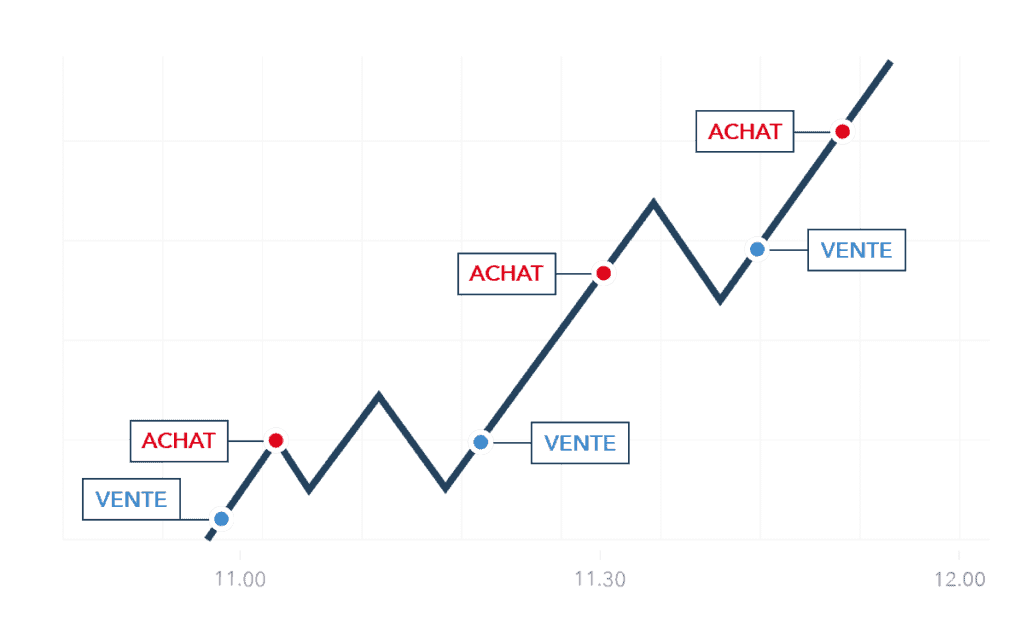How to invest in the stock market with a PEA

Investing in the stock market with a PEA is very popular with savers. Thanks to its advantageous taxation on capital gains and dividends received, it boosts investment performance while reducing the tax bill. The PEA also offers the possibility of diversifying one's savings between many vehicles such as shares, ETFs, funds, warrants, etc.
But to take full advantage of its PEA, it is still necessary to understand how it works and implement an appropriate investment strategy.
- ✔️What are the eligible supports?
- 👉 How to take advantage of each type of asset?
- ✔️ Which allocation to adopt between live shares, ETFs and funds?
So many questions that we will answer in this article to allow you to optimize your PEA. Thanks to this valuable advice, you will know how to build an efficient and resilient PEA portfolio, capable of boosting your stock market returns in the long term while controlling risks.

Get 200% Bonus after your first deposit. Use this promo code: argent2035
Prepare to become an ace of PEA management! 📈 But before we start, here is How to get out of debt?
Let's go !!
🌿What is a PEA?
The PEA (The Savings Plan in Actions) is a stock savings scheme intended for individual investors. 💰 It allows you to invest in shares of European companies, but also in shares of certain UCITS (Collective Investment Organizations in Transferable Securities) such as SICAVs (Variable Capital Investment Companies) and FCPs (Common Funds of Placement).
Here are some important details to know about the PEA:
Avantages fiscaux: Capital gains made on securities held in a PEA are exempt from income tax, provided they respect a minimum holding period of 5 years. In addition, dividends received are subject to a single flat-rate levy (PFU) of 30%, including income tax and social security contributions.
Payment limits : The PEA is subject to payment ceilings. Currently, the ceiling is set at 150 euros for an individual PEA and at 000 euros for a joint PEA. It is important to note that payments made to a PEA cannot be recovered once the ceiling has been reached.
Minimum detention period: To benefit from the capital gains tax exemption, it is necessary to keep the securities in the PEA for at least 5 years. If you make a withdrawal before this period, you will be subject to tax on the capital gains made.
Transfer of the PEA: It is possible to transfer your PEA from one bank to another, while maintaining your tax seniority. However, it is important to respect certain rules and pay attention to possible costs linked to this transfer.
Use of cash: The sums available in a PEA can be used to make new investments or to make partial withdrawals. However, it is important to keep in mind that any withdrawal made before the minimum holding period will result in the closure of the PEA and the taxation of the capital gains made.
🌿 Who can open a PEA?
The PEA can be opened by any adult natural person. Minors can also open a PEA, but with the agreement of their legal representative. It is important to note that each person can only hold one PEA, whether individual or joint. In addition, it is not possible to open a PEA in the name of a company or legal entity.
To open a PEA, it is necessary to provide certain supporting documents, such as a valid identity document and recent proof of address. It is also possible that the bank or online broker asks for additional information about the investor, such as their professional situation and income.
Finally, it is important to note that the PEA is subject to payment ceilings, set at 150 000 euros for an individual PEA and 300 euros for a joint PEA.
🌿How to open a PEA?
The opening of a PEA is quick and easy. ✅ To open a PEA, you must first choose a financial institution authorized to offer this savings product. This could be a traditional bank or an online broker.
Then, you must contact this establishment and provide the supporting documents necessary to open the PEA, such as a valid identity document and recent proof of address.
It is also possible that the bank or online broker will request additional information about your professional situation and your income. Once all supporting documents have been provided, the financial institution will open the PEA.
🌿 What investments can be made in a PEA?
In a PEA, it is possible to invest in shares of European companies listed on a regulated market, as well as in certain UCITS such as SICAVs and FCPs. Shares eligible for the PEA must meet certain criteria, such as being issued by companies having their head office in the European Union or in a member state of the European Economic Area.
Additionally, the shares must be listed on a regulated market, such as Euronext Paris or the London Stock Exchange.
It is important to note that certain financial products are not eligible for PEA, such as warrants, certificates and bonds convertible into shares. In addition, it is prohibited to use the sums invested in the PEA as guarantee for a loan or a credit transaction.
🌿 How to manage your PEA over time?
Investing in the stock market with a PEA (Stock Savings Plan) requires a strategic approach and prudent management over time. Firstly, it is essential to define a clear investment objective, whether for long-term growth, income generation or a combination of the two. Once this objective has been established, the selection of actions eligible for the PEA must be carefully carried out.
La portfolio diversification is a recommended practice to reduce risk. By spreading investments across different asset classes and sectors, market fluctuations will have less impact on the overall portfolio. I
It is also crucial to stay informed about developments in the financial markets, economic news and the performance of the companies in which you have invested.
La patience is a virtue when it comes to managing a PEA. Stock markets may experience short-term fluctuations, but the focus should be on the long-term view. Avoid succumbing to impulsive reactions to temporary market movements.
A disciplined investment strategy involves staying true to your original plan and adjusting positions based on economic developments rather than emotional market movements.
Periodic portfolio rebalancing is a recommended practice. This involves readjusting the proportions of different assets according to changes in their relative value. This helps maintain diversification and ensures the portfolio remains aligned with initial financial goals.
Finally, the regularity of investments can be beneficial. Rather than trying to time the market, consider investing fixed amounts at regular intervals, which helps smooth out market fluctuations over time.

Get 200% Bonus after your first deposit. Use this official Promo code: argent2035
🌿 What investment strategy to adopt in your PEA?
Several options are available to you for investing in your PEA. 📊 Here are some typical strategies:
Live action
Investing in individual stocks can offer significant growth potential, but it also carries a higher level of risk. It is essential to conduct in-depth fundamental analysis on the selected companies.
La portfolio diversification of individual actions is equally crucial to mitigating company-specific risks.
Risky securities (small caps, biotechs, etc.)
Riskier securities, such as small cap stocks or biotechnology companies, may offer higher returns, but they are also more volatile. They should be considered with caution and possibly incorporated into a diversified portfolio to offset risk.
Equity funds
Investment funds, particularly equity funds, can offer instant diversification. UCITS (Undertakings for Collective Investment in Transferable Securities) allow investors to delegate management to professionals who select a diversified basket of shares.
It is important to choose funds based on investment objective, past performance and fees.
ETFs (Exchange-Traded Funds)
ETFs generally track the performance of a specific stock index. They offer instant diversification and are traded on stock exchanges like stocks. ETFs can be a cost-effective option for tracking specific markets or sectors without having to select individual stocks.
Thematic investing
Some investors choose to focus on specific themes such as renewable energy, technology, healthcare, etc. Thematic funds or thematic ETFs can be used to take advantage of these specific market trends.
Active management vs. passive management
Active management involves the manual selection of stocks or funds by a portfolio manager, while passive management involves tracking a specific index. Investors can choose between these approaches based on their preferences, market beliefs and investment horizon.
Risk management
Whatever strategy is chosen, the risk management is crucial. This involves setting acceptable loss limits, monitoring the portfolio regularly, and adjusting composition accordingly. Diversification, both at the asset and sector level, plays a key role in risk management.
It is important to note that investment choices depend on each individual's personal preferences, financial goal and risk tolerance. Prudent diversification and regular monitoring remain fundamental principles of portfolio management, regardless of the types of assets chosen within the framework of a PEA.
🌿 Which sectors should be favored in your PEA?
Choosing which sectors to focus on in a PEA depends on several factors, including your investment objectives, your risk tolerance and your time horizon. Here are some sectors that may be considered, but keep in mind that diversification remains key to reducing sector-specific risks:
Technology: Technology companies can offer significant growth potential. However, the industry is often volatile, and it is important to monitor emerging technology trends and the performance of individual companies.
Health and biotechnology: With the aging population, the healthcare and biotechnology sector may present growth opportunities. However, it is crucial to understand pharmaceutical and biotechnology product development cycles, as well as industry regulations.
Renewable energies: Investments in renewable energy are increasingly popular due to the transition to more sustainable energy sources. Companies engaged in solar, wind, and other clean energy sources could benefit from long-term trends.
Discretionary consumption: This sector encompasses non-essential goods and services, such as travel, leisure and fashion. It can be sensitive to economic fluctuations, but discretionary consumption can also benefit from periods of economic growth.
Finance and banks: The financial sector, including banking, insurance and financial services, can be influenced by overall economic conditions. Performance can be closely linked to interest rates and economic policies.
🌿 What individual actions should be included in your PEA?
Choosing which individual stocks to include in a PEA depends on various factors, including your investment objectives, time horizon, risk tolerance and personal market analysis. Here are some general considerations and some examples of companies you might consider.
French blue chips: Large French companies, often called “blue chip“, are generally considered more stable investments due to their size and market position. This may include CAC 40 companies such as L'Oréal, TotalEnergies, Sanofi, etc.
Technology: Global technology companies can offer significant growth potential. For example, companies like Dassault Systèmes, Capgemini or STMicroelectronics are important players in the technology field.
Health and biotechnology: Healthcare companies can be included to diversify your portfolio. Sanofi, EssilorLuxottica or Thales may be options to consider.
Renewable energies: If you are interested in renewable energy, companies such as TotalEnergies, Engie, or Orsted (if you accept foreign stocks) could be included in your portfolio.
Consumer goods : Companies that provide consumer staples, such as L'Oréal, Danone, or LVMH, may be considered for the stability they bring to a portfolio.
Industry: Industrial companies such as Airbus, Safran or Vinci can be included to participate in economic growth and infrastructure projects.
It is important to note that diversification is crucial to mitigating company- or sector-specific risks.
🌿 Which ETFs to choose as part of a PEA?
The choice of Exchange-Traded Funds (ETF) for an Equity Savings Plan (PEA) depends on your investment strategy, your financial objectives and your risk tolerance. ETFs are exchange-traded index funds that track the performance of an underlying index. Here are some ETFs that could be considered as part of a PEA, with an emphasis on indices linked to the French or European market:
Lyxor CAC 40 (LYX0PA): This ETF replicates the performance of the CAC 40, the flagship index of the Paris Stock Exchange, which brings together the 40 largest French companies.
Amundi MSCI Europe UCITS ETF (CEUD): This ETF tracks the MSCI Europe Index, providing exposure to a wide range of European companies, including French.
iShares EURO STOXX 50 UCITS ETF (C50): This ETF tracks the EURO STOXX 50 index, made up of the 50 largest companies in the euro zone. It offers geographic diversification.
Lyxor MSCI EMU Small Cap UCITS ETF (MMS): If you are interested in Eurozone small caps, this ETF tracks the MSCI EMU Small Cap Index.
Amundi Index MSCI Europe SRI UCITS ETF (EUR): For investors interested in environmental, social and governance (ESG) criteria, this ETF tracks the MSCI Europe SRI index.
BNP Paribas Easy STOXX Europe 600 UCITS ETF (EXSA): This ETF tracks the STOXX Europe 600 index, which includes companies from several European countries.
Lyxor MSCI World UCITS ETF (WLDR): For global exposure, this ETF tracks the MSCI World Index, encompassing developed market companies globally.
Before choosing an ETF, make sure you understand the underlying index's tracking methodology, associated fees, and the composition of the fund. Additionally, keep in mind that diversification remains important, even with ETFs. It is always recommended to do thorough research or consult a financial advisor before making any investment decisions.
🌿 The risks of investing in the stock market
Investing in the stock market comes with growth opportunities, but it is also important to understand and manage the associated risks. Here are some of the main risks investors should consider:
Market risk: Financial markets are subject to volatility. Stock prices can fluctuate due to a variety of factors, such as economic conditions, political events, interest rates, and even market moods. Investors may suffer losses if the market in which they invest experiences significant declines.
Financial risk: Some companies may experience financial difficulties, and investors may suffer losses if a company they have invested in goes bankrupt. It is essential to understand the financial strength of companies before investing.
Sector risk: Stock performance can be influenced by sector-specific factors. For example, technology companies may be affected by rapid technological advancements, while energy companies may be sensitive to fluctuations in commodity prices.
Company-specific risk: Every business has its own specific risks, such as management issues, legal disputes, scandals, etc. It is important to understand these specific risks before investing in a company.
Risk of change : If you invest in foreign stocks or funds, changes in exchange rates may affect the value of your investments when converted to your local currency.
Liquidity risk: Some assets may lack liquidity, meaning it may be difficult to sell them quickly without affecting their price. This can be a problem, especially for investors who need short-term liquidity.
🌿 When can you withdraw your earnings from a PEA?
To continue to benefit from the PEA tax advantage, you must keep it open for at least 5 years from the first payment. 🗓️ After this deadline, you can withdraw your winnings whenever you want. They will be exempt from income tax (excluding social security contributions).
Closure of the PEA before 5 years: When you decide to close your Stock Savings Plan (PEA) before the fifth anniversary of its opening, the gains generated are subject to income tax, in addition to social security contributions. This situation may result in higher taxation compared to a PEA closed after 5 years.
After 5 years: Once your PEA has exceeded the five-year period, the gains made benefit from an income tax exemption. However, social security contributions continue to apply. It is crucial to note that any withdrawal before the eighth anniversary of the opening of the PEA results in the closure of the account.
Between 5 and 8 years old: If you choose to make withdrawals between the fifth and eighth years, the earnings are exempt from income tax, but social security contributions remain in force. After eight years, earnings and withdrawals are completely exempt from income tax and social security contributions.
Partial or total withdrawals: You have the freedom to withdraw part or all of your capital and winnings at any time. Partial withdrawals do not necessarily compromise the tax benefits of the PEA, as long as the account is not closed.
Specific conditions for exempt winnings: In order to benefit from the tax exemption on earnings after 5 years, it is imperative to keep the PEA open and active. Closing the PEA before the fifth anniversary results in the gains being taxed.
Transfer of the PEA: It is possible to transfer your PEA from one bank to another while preserving the tax advantages, provided that you respect certain rules and procedures. A financial professional can provide advice specific to your situation to optimize your earnings while complying with current tax rules.
🌿 Can the PEA be passed on to his heirs?
The PEA benefits from a advantageous succession. ✅ In the event of the death of its holder, the PEA is automatically transferred to the surviving spouse. He retains his tax precedence and can continue to benefit from it.
If the holder was single, the PEA is closed and treturned to designated heirs. But there is no inheritance tax, thanks to the income tax exemption. Only the social contributions are due.
🌿 Closing
In conclusion, investing in the stock market with a Stock Savings Plan (PEA) offers captivating opportunity to access financial markets while benefiting from significant tax advantages. However, this adventure requires a thoughtful approach and a thorough understanding of the mechanisms of PEA.
We've explored the diversity of choices available, from individual stocks to ETFs, highlighting investment strategies and inherent risks. The key lies in the definition of investment objectives clear, portfolio diversification to mitigate risks, and prudent management of the PEA over time.
Let us not forget the importance of patience and discipline in investment. By maintaining a long-term perspective, regularly monitoring their portfolio and strategically adjusting their positions, the investor can maximize the chances of success while taking advantage of the tax advantages of the PEA.




















Leave comments